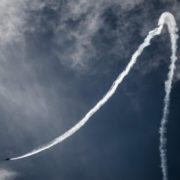Braking Action.
BRAKE PROBLEMS
ATC:
- Inform pilot about runway length and condition (długość i stan)
- Monitor height, speed, distance from touchdown
- Plan ahead the pending (oczekujący) traffic, consider assigning priority (przydzielenie pierwszeństwa) to the arrivals if necessary due to possibility of blocked runway (ze względu na możliwość zablokowania pasa)
- Make arrangements for towing equipment (sprzęt holujący) to be on stand-by as appropriate
- Request help of technical staff required to inspect and assess the damage to the aircraft as appropriate
- If pilot reports vibrations during the take-off/landing roll – consider possible tyre burst/debris (pozostałości/ szczątki) on the runway and make the necessary arrangements for runway inspection. Inform the pilot if tyre burst has occurred, especially important if it took place after take-off.
Best practice embedded in the ASSIST principle could be followed (A – Acknowledge; S – Separate, S – Silence; I – Inform, S – Support, T – Time):
A – acknowledge the emergency, inform the crew if fire/smoke is observed from the undercarriage area;
S – separate the aircraft and if necessary prioritise it for landing (nadać pierszeństwo do lądowania), allow long final if requested, keep the active runway clear of departures, arrivals and vehicles;
S – silence the non-urgent calls (as required) and use separate frequency where possible;
I – inform the airport emergency fire rescue services and all concerned parties according to local procedures; as tower controller expect airport authorities to execute their emergency plan; inform the supervisor and other sectors/units concerned;
S – support the flight by providing any information requested and necessary such as type of approach, runway length and aerodrome details, etc.
T – provide time for the crew to assess the situation (ocenić sytuację), don’t press with non urgent matters.
WATCH THE FILM AND LEARN THE WORDS!
Moduł językowy opracowany na podstawie materiału:
http://www.skybrary.aero/index.php/Brake_Problems:_Guidance_for_Controllers











